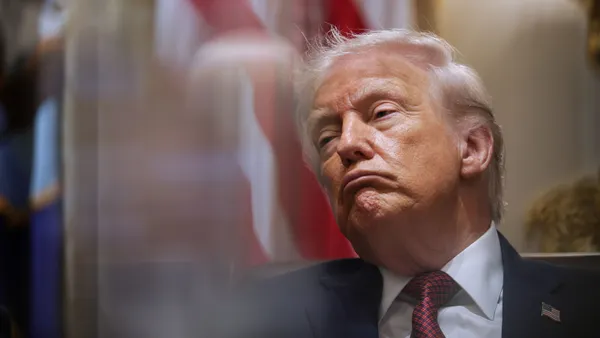Dive Brief:
- The U.S. and China will hold additional rounds of trade talks this week in Washington, the White House announced Monday.
- "Deputy-level meetings" begin Tuesday, the White House said, led by Deputy United States Trade Representative Jeffrey Gerrish. The U.S. will hold "principal-level meetings" starting Thursday. U.S. Trade Representative Robert Lighthizer will lead those talks, which will also include Treasury Secretary Steve Mnuchin, Commerce Secretary Wilbur Ross, Assistant to the President for Economic Policy Larry Kudlow and Assistant to the President for Trade and Manufacturing Policy Peter Navarro.
- The two countries will discuss structural changes related to trade and China's agreement to "purchase a substantial amount of goods and services" from the U.S., but did not offer additional details, the White House said.
Dive Insight:
The administration has kept mum for the most part on details of the ongoing trade talks between Washington and Beijing.
After the most recent round of talks, which took place in Beijing, U.S. officials touted "progress" on trade issues the two countries set out to resolve during a 90-day negotiation period, but they offered no specific detail on what that progress entailed.
China purchased shipments of soybeans from the U.S. (the exact amount is unclear) since the trade talks began, a sign of progress in China agreeing to import "substantial" amounts of goods from the U.S. On structural issues such as intellectual property and technology transfer, however, neither the U.S. nor China has revealed any specific progress.
Donald Trump hinted last week he might consider an extension to the March 1 trade negotiation deadline, although the White House made no mention of that in its latest announcement on continuing trade talks. Lighthizer previously called March 1 "a hard deadline."
The numerous unknowns surrounding trade talks and deadlines leave businesses in a state of uncertainty related to tariffs.
Economic Policy Uncertainty uses economic data and news reports to create a monthly index of uncertainty. In January 2019, it measured U.S. uncertainty at an index of 292, an all-time high since the index began tracking data in 1997 and slightly higher than the global index of 285. In January 2017, the U.S. index measured just 161.
Still, analysts are hopeful the U.S. and China will reach a deal later this year, though it likely will come after the March 1 deadline, and it's unclear what effect the trade deal would have on existing and future tariffs.














